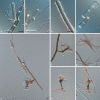Myrtaceae, a cache of fungal biodiversity
- PMID: 20198162
- PMCID: PMC2802731
- DOI: 10.3767/003158509X474752
Myrtaceae, a cache of fungal biodiversity
Abstract
Twenty-six species of microfungi are treated, the majority of which are associated with leaf spots of Corymbia, Eucalyptus and Syzygium spp. (Myrtaceae). The treated species include three new genera, Bagadiella, Foliocryphia and Pseudoramichloridium, 20 new species and one new combination. Novelties on Eucalyptus include: Antennariella placitae, Bagadiellalunata, Cladoriella rubrigena, C. paleospora, Cyphellophora eucalypti, Elsinoë eucalypticola, Foliocryphia eucalypti, Leptoxyphium madagascariense, Neofabraea eucalypti, Polyscytalum algarvense, Quambalaria simpsonii, Selenophoma australiensis, Sphaceloma tectificae, Strelitziana australiensis and Zeloasperisporium eucalyptorum.Stylaspergillus synanamorphs are reported for two species of Parasympodiella, P. eucalypti sp. nov. and P. elongata, while Blastacervulus eucalypti, Minimedusa obcoronata and Sydowia eucalypti are described from culture. Furthermore, Penidiella corymbia and Pseudoramichloridium henryi are newly described on Corymbia, Pseudocercospora palleobrunnea on Syzygium and Rachicladosporium americanum on leaf litter. To facilitate species identification, as well as determine phylogenetic relationships, DNA sequence data were generated from the internal transcribed spacers (ITS1, 5.8S nrDNA, ITS2) and the 28S nrDNA (LSU) regions of all taxa studied.
Keywords: Corymbia; Eucalyptus; Syzygium; microfungi; taxonomy.
Figures


























Similar articles
-
Fungal Planet description sheets: 951-1041.Persoonia. 2019;43:223-425. doi: 10.3767/persoonia.2019.43.06. Epub 2019 Dec 18. Persoonia. 2019. PMID: 32214501 Free PMC article.
-
Foliar pathogens of eucalypts.Stud Mycol. 2019 Aug 8;94:125-298. doi: 10.1016/j.simyco.2019.08.001. eCollection 2019 Sep. Stud Mycol. 2019. PMID: 31636729 Free PMC article.
-
Fungal Planet description sheets: 469-557.Persoonia. 2016 Dec;37:218-403. doi: 10.3767/003158516X694499. Epub 2016 Dec 21. Persoonia. 2016. PMID: 28232766 Free PMC article.
-
Fungal Planet description sheets: 868-950.Persoonia. 2019 Jun;42:291-473. doi: 10.3767/persoonia.2019.42.11. Epub 2019 Jul 19. Persoonia. 2019. PMID: 31551622 Free PMC article.
-
Fungal Planet description sheets: 785-867.Persoonia. 2018 Dec;41:238-417. doi: 10.3767/persoonia.2018.41.12. Epub 2018 Dec 14. Persoonia. 2018. PMID: 30728607 Free PMC article.
Cited by
-
Genera of diaporthalean coelomycetes associated with leaf spots of tree hosts.Persoonia. 2012 Jun;28:66-75. doi: 10.3767/003158512X642030. Epub 2012 Apr 17. Persoonia. 2012. PMID: 23105154 Free PMC article.
-
Taxonomy and phylogeny of the basidiomycetous hyphomycete genus Hormomyces.Fungal Syst Evol. 2021 Jun;7:177-196. doi: 10.3114/fuse.2021.07.09. Epub 2021 Feb 12. Fungal Syst Evol. 2021. PMID: 34124623 Free PMC article.
-
Fungal Planet description sheets: 128-153.Persoonia. 2012 Dec;29:146-201. doi: 10.3767/003158512X661589. Epub 2012 Dec 20. Persoonia. 2012. PMID: 23606771 Free PMC article.
-
Chaetocapnodiummagnum and Chaetocapnodiumpolonicum from conifer resins disclose an unknown lifestyle in the Capnodiales (Dothideomycetes).MycoKeys. 2025 Jul 14;119:315-333. doi: 10.3897/mycokeys.119.159094. eCollection 2025. MycoKeys. 2025. PMID: 40697982 Free PMC article.
-
Species and ecological diversity within the Cladosporium cladosporioides complex (Davidiellaceae, Capnodiales).Stud Mycol. 2010;67:1-94. doi: 10.3114/sim.2010.67.01. Stud Mycol. 2010. PMID: 20877444 Free PMC article.
References
-
- Adhikari RS. 1990. Some new host records of fungi from India – IV. Indian Phytopathology 43: 593 – 594
-
- Alves A, Crous PW, Correia A, Phillips AJL. 2008. Morphological and molecular data reveal cryptic speciation in Lasiodiplodia theobromae. Fungal Diversity 28: 1 – 13
-
- Arzanlou M, Crous PW. 2006. Strelitziana africana. Fungal Planet no. 8
-
- Ball JB. 1995. Development of Eucalyptus plantations – an overview. In: White K, Ball J, Kashio M. (eds), Proceedings of the Regional Expert Consultation on Eucalyptus Vol. I. Bangkok, Thailand 4–8 October 1993: 15–27 FAO Regional Office for Asia and the Pacific, Bangkok, Thailand:
LinkOut - more resources
Full Text Sources
Molecular Biology Databases
Miscellaneous
